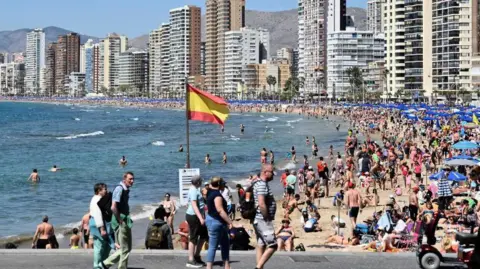Business reporter
 Getty Images
Getty ImagesIt’s a chilly mid-winter afternoon in Segovia, in central Spain, and tourists are gathered at the foot of the city’s Roman aqueduct, gazing up at its famous arches and taking selfies.
Many of the visitors are Spanish, but there are also people from other European countries, Asians and Latin Americans, all drawn by Segovia’s historic charm, gastronomy and dramatic location just beyond the mountains north of Madrid.
“There was a moment during Covid when I thought ‘maybe tourism will never, ever be like it was before’,” says Elena Mirón, a local guide dressed in a fuchsia-coloured beret who is about to lead a group across the city.
“But now things are very good and I feel this year is going to be a good year, like 2023 and 2024. I’m happy, because I can live off this job I love.”

Spain received a record 94 million visitors in 2024 and is now vying with France, which saw 100 million, to be the world’s biggest foreign tourist hub.
And the tourism industry’s post-Covid expansion is a major reason why the eurozone’s fourth-biggest economy has been easily outgrowing the likes of Germany, France, Italy and the United Kingdom, posting an increase in GDP of 3.2% last year.
By contrast, the German economy contracted by 0.2% in 2024, while France grew by 1.1%, Italy by 0.5%, and the UK by an expected 0.9%.
This all helps explain why the Economist magazine has ranked Spain as the world’s best-performing economy.
“The Spanish model is successful because it is a balanced model, and this is what guarantees the sustainability of growth,” says Carlos Cuerpo, the business minister in the Socialist-led coalition government. He points out that Spain was responsible for 40% of eurozone growth last year.
Although he underlined the importance of tourism, Mr Cuerpo also pointed to financial services, technology, and investment as factors which have helped Spain bounce back from the depths of the pandemic, when GDP shrank by 11% in one year.
“We are getting out of Covid without scars and by modernising our economy and therefore lifting our potential GDP growth,” he adds.

That modernisation process is being aided by post-pandemic recovery funds from the EU’s Next Generation programme. Spain is due to receive up to €163bn by 2026 ($169bn; £136bn), making it the biggest recipient of these funds alongside Italy.
Spain is investing the money in the national rail system, low-emissions zones in towns and cities, as well as in the electric vehicle industry and subsidies for small businesses.
“Public spending has been high, and is responsible for approximately half our growth since the pandemic,” says María Jesús Valdemoros, lecturer in economics at Spain’s IESE Business School.
Other major European economies have seen their growth stymied by their greater reliance than Spain on industry, which, she says, “is suffering a lot at the moment due to factors such as the high cost of energy, competition from China and other Asian countries, the cost of the transition to a more sustainable environmental model and trade protectionism”.
Since Covid, the other major economic challenge for Spain has been the cost-of-living crisis triggered by supply-chain bottlenecks and the Russian invasion of Ukraine in 2022. Inflation peaked at an annual rate of 11% in July of that year, with energy prices hitting Spaniards particularly hard, but by the end of 2024 it had fallen back to 2.8%.
Madrid believes that subsidies it introduced to cut the cost of fuel consumption and encourage public transport use were key in mitigating the impact of the energy price rises, as well as several increases to the minimum wage.
At the height of the European energy crisis, Spain and Portugal also negotiated with Brussels a so-called “Iberian exception”, allowing them to cap the price of gas used to generate electricity in order to reduce consumers’ bills.
Mr Cuerpo argues that such measures have helped counter Spain’s traditional vulnerability to economic turmoil.
“Spain is proving to be more resilient to successive shocks – including the inflation shock that came with the war in Ukraine,” he said. “And I think this is part of the overall protective shield that we have put in place for our consumers and for our firms.”
The country’s green energy output is seen as another favourable factor, not just in guaranteeing electricity, but also spurring investment. Spain has the second-largest renewable energy infrastructure in the EU.
The latter is a boon for a country that is Europe’s second-biggest car producer, according to Wayne Griffiths, the British-born CEO of Seat and Cupra. Although Spanish electric vehicle production is lagging behind the rest of Europe, he sees enormous potential in that area.
“[In Spain] we have all the factors you need to be successful: competitive, well-trained people and also an energy policy behind that,” he says. “There’s no point in making zero-emission cars if you’re using dirty energy.”
Despite these positives, a longstanding weakness of Spain’s economy has been a chronically high jobless rate, which is the biggest in the EU and almost double the block’s average. However, the situation did improve in the last quarter of 2024, when the Spanish jobless unemployment rate declined to 10.6%, its lowest level since 2008.
Meanwhile the number of people in employment in Spain now stands at 22 million, a record high. A labour reform, encouraging job stability, is seen as a key reason for this.
This reform increased restrictions on the use of temporary contracts by companies, favouring greater flexibility in the use of permanent contracts. It has reduced the number of workers in temporary employment without hindering job creation.
Also, although the arrival of immigrants has driven a fierce political debate, their absorption into the labour market is seen by many as crucial for a country with a rapidly ageing population.
The Socialist prime minister, Pedro Sánchez, has been outspoken in underlining the need for immigrants, describing their contribution to the economy as “fundamental”.
The European Commission has forecast that Spain will continue to lead growth among the bloc’s big economies this year and remain ahead of the EU average. However, challenges are looming on the horizon.
 Getty Images
Getty ImagesThe heavy reliance on tourism – and a growing backlash against the industry by local people – is one concern.
Another is Spain’s vast public debt, which is higher than the country’s annual economic output.
María Jesús Valdemoros warns that this is “an imbalance that we need to correct, not just because the EU’s new fiscal norms demand it, but because it could cause financial instability”.
In addition, a housing crisis has erupted across the country, leaving millions of Spaniards struggling to find affordable accommodation.
With an uncertain and deeply polarised political landscape, it is difficult for Sánchez’s minority government to tackle such problems. But, while it attempts to resolve these conundrums, Spain is enjoying its status as the motor of European growth.
Source link
